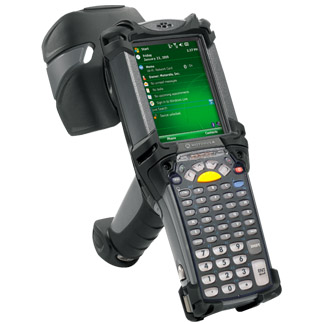Input Devices:
Sensor; convert a real world properties into data that computer can process e.g.- temperature sensor-detect temperature (to control the temperature e.g. in science experiments)
- pressure sensor-detect pressure (e.g. someone standing on it)
- light sensor-detect light (control light e.g. in music concert)
Radio Frequency Identification (RFID) readers; used to gather information from an RFID tag, which is used to track individual objects. This performed by the radio waves which use to transfer data from the tag to a reader
Uses:
- passports
- smart cards
- airplane luggage
- toll booth passes
- home appliances etc
Magnetic Ink Character reader (MICR); allows details from bank cheques to be read into a computer quickly and accurately.
Optical Mark Reader; allows the data from a multiple-choice type form to be read into a computer.
Uses:
Optical character reader (OCR); can convert different types of documents, such as scanned paper documents, PDF files or images captured by a digital camera into editable and searchable data.
Bar code reader; allow the data from bar code (simply numeric code) to be read into a computer.
Magnetic stripe readers; hardware device that reads the information encoded in the magnetic stripe located on the back of a plastic badge.
 Output devices:
Output devices:
Monitor; screen that put up peripheral output to the user e.g.
- CRT monitor-cathode ray tube-display screen; the type that has been around for years and is large and boxy.
Uses; design industry
Advantages: colour accuracy andbrightness of CRT monitors is excellent
Disadvantages: heavy and they take up a lot of desk space
- TFT (Thin Film Transistor)/LCD (Liquid Crystal Display) monitor; flat screen monitor, they replaced CRT monitor.
Uses: television sets, monitor screen, mobile phones etc
Advantages: light in weight and they take up very little desk space, also has picture quality that is as good as CRT monitors.
Disadvantages: the colors are not always correctly transcribed.
- IPS (In Plane Switching)/LCD monitor ; screen technology used for liquid crystal displays (LCDs)
Uses: main limitations of the twisted nematic field effect (TN) matrix LCDs in the late 1980s
Advantages: wide viewing angles, better colour accuracy
Disadvantages: required 15% more power than TN monitor.
- LED (Light Emitting Diode) monitor; semiconductor device that emits visible light when an electric current passes through it.
Advantages: perfectly flat screen, produce very bright image,
Disadvantages: limited viewing angle, bad pixel and screen uniformity
Printers:
 Dot matrix printer; a type of computer printing which uses a print head that moves back-and-forth, prints by impact, striking an ink-soaked cloth ribbon against the paper.
Dot matrix printer; a type of computer printing which uses a print head that moves back-and-forth, prints by impact, striking an ink-soaked cloth ribbon against the paper.
Uses: multi-part forms and address labels
Advantages: thicker media better than laser and inkjet printers
Disadvantages: lowest printing costs per page, ink is running out, the printout gradually fades.
Advantages: high quality printing
3D printers; print out the process that builds layers to create a three-dimensional solid object from a digital model.
Uses : print organs from a patient's own cells, print 3D model
Advantages: can print out 3D shapes, no storage cost
Disadvantages: limitations of size, limitations of raw material


A black screen on CRT monitors appears true black due to the absence of light emission, unlike LCD, IPS, and LED monitors where backlight bleed can make blacks look gray. LED monitors struggle with black screen uniformity, revealing inconsistencies in brightness or dead pixels, while IPS provides better color accuracy even on black screens.https://blackscreen.onl
ReplyDelete